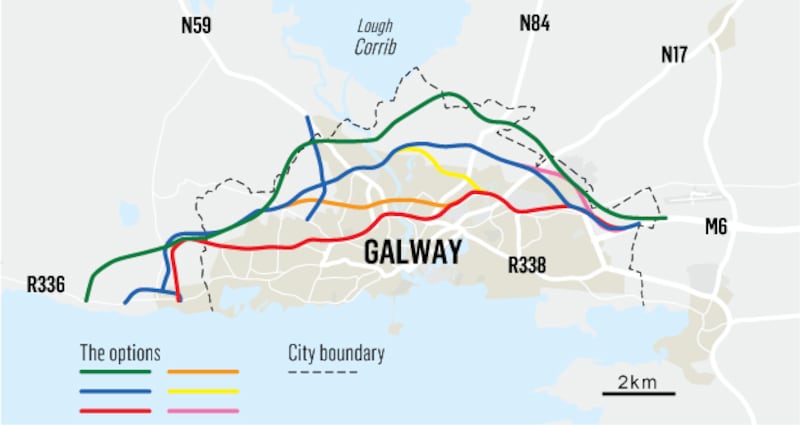If Galway becomes European cultural capital in 2020, by then cruise liners may be berthing in a new port south of the Claddagh and Connemara-bound Dubliners may be bypassing the city over the Garry Hynes bridge or through the Tommy Tiernan tunnel.
That's if separate multi-million euro designs for an expanded harbour and for an outer motor route receive An Bord Pleanála sanction. The former project was the subject of a recent oral hearing and the latter is at early planning stage.
Throw in Minister for the Environment Alan Kelly’s new review of its urban boundaries and there’s much public discussion about how the future will look – even as population continues to grow andclimate change has a subtle impact.

The highlights of seven options unveiled this week as part of a Government-sanctioned bid to resolve Galway’s gridlock and speed up travel further west include three crossings over and one tunnel under the river Corrib and the demolition of between 30 and 120 homes.
City and county areas from Barna and Newcastle in the west to Menlo, Coolagh and Ballybrit in the east are within the study area. More than 300 people received letters within the last week to notify them they could be directly affected.
Almost 4,500 landowners, businesses and householders in total fall within the remit of the “corridors”, but this will be narrowed down considerably when a final preferred option is selected by mid-April.
Public transport
The seven options – six road corridors and one dedicated “smarter” public transport approach – will cost between €500 million and €750 million, with funding under a public-private partnership.
Last year the Department of Transport allocated €2 million to “reboot” the outer bypass, after €14 million expenditure on a previous, now abandoned, scheme.
All of the six road corridors lie south of the previous proposed project, which was first mooted in 1999. An Bord Pleanála refused permission for the western section on environmental grounds and the Supreme Court quashed permission for the eastern section.
Galway city and county councils have now returned to the drawing board with the National Roads Authority (NRA) and consulting engineers Arup.
Five of the six bypass corridors run through sensitive habitats, but there is no direct impact on any priority habitat within a Special Conservation Area (SAC), according to the designers. Some 2,500 hectares have been surveyed by up to 60 ecologists since the new project group was established.
The one corridor with no habitat implications has many human ones as it runs through the densely populated suburb of Knocknacarra and draws on the existing road network.
The selection of so many options is intended to meet the requirements of EU Habitats Directive’s article 6 (4) clause. Under this clause, a project located in a sensitive habitat may be approved if a case can be made that there are no alternatives.
The IROPI (imperative reasons of overriding public interest) provision – as Article 6 (4) is known – was first used to seek approval for a motorway in Hessen, Germany. Galway Harbour Company has used it to make a case for its harbour expansion plan.
Fine Gael councillor Frank Fahy, whose brother is among potentially affected landowners, says a balance will have to be struck between ecology and people's homes and businesses.
Fianna Fáil councillor Mike Crowe lives in Coolagh on the east side, near Briarhill. He received a letter in the past week to say his home is on the green route, which also cuts through the Gaeltacht village of Menlo. He says a final route could involve a mix of options.
Badly needed
“I am still totally in support of this project. Galway had been stagnant up till now and this bypass is badly needed,” he said. “Galway is growing and Minister
Kelly
is reviewing city boundaries. Will that mean the city expands over this outer bypass and it becomes outdated?”
Independent city councillor Catherine Connolly says city expansion into the new suburb of Ardaun demands that a light rail option be examined.
“Light rail has already been favoured in a city council motion and I can’t understand why we aren’t looking at it now,”she said.
However, the N6 project team says it has been considered, that it doesn’t solve the problem now but might form part of a future multi-modal public transport option.
In her submission to the oral hearing on the harbour plan last week, Ms Connolly said regeneration of Iarnród Éireann’s Ceannt Station and proposed expansion of the harbour should be considered together.
Bypass options: new routes
Green route: Connects R336 to west of Barna and follows outer route north to the N59 before crossing the river Corrib to the north of Menlo Castle and continuing northeast through Menlo to Ballindooley and southeast to Coolagh.
Blue route: involved completing Barna relief road and running north of Knocknacarra to Dangan, crossing the river Corrib midway between Quincentenary bridge and Lough Corrib and continuing through Castlegar and Ballybrit.
Red route: links R336 to east of Barna with existing Western Distributor Road in Knocknacarra. Involves cut and cover tunnels/bridges to create a two-tier system of segregating national traffic form local road network.
Orange route: similar to red route as far as Western Distributor Road connection and then follows blue route to N59 junction. A tunnel would connect Letteragh on the west to Terryland on the east.
Yellow route: similar to blue route as far as Menlo, and proceeds southeast to line to red route at Castlegar.
Pink route: similar to blue route, varying only at Ballybrit. Public consultation on N6 Galway City Transport Project continues at the Menlo Park Hotel,Terryland, Galway next Tuesday and Wednesday from 2pm to 8pm














